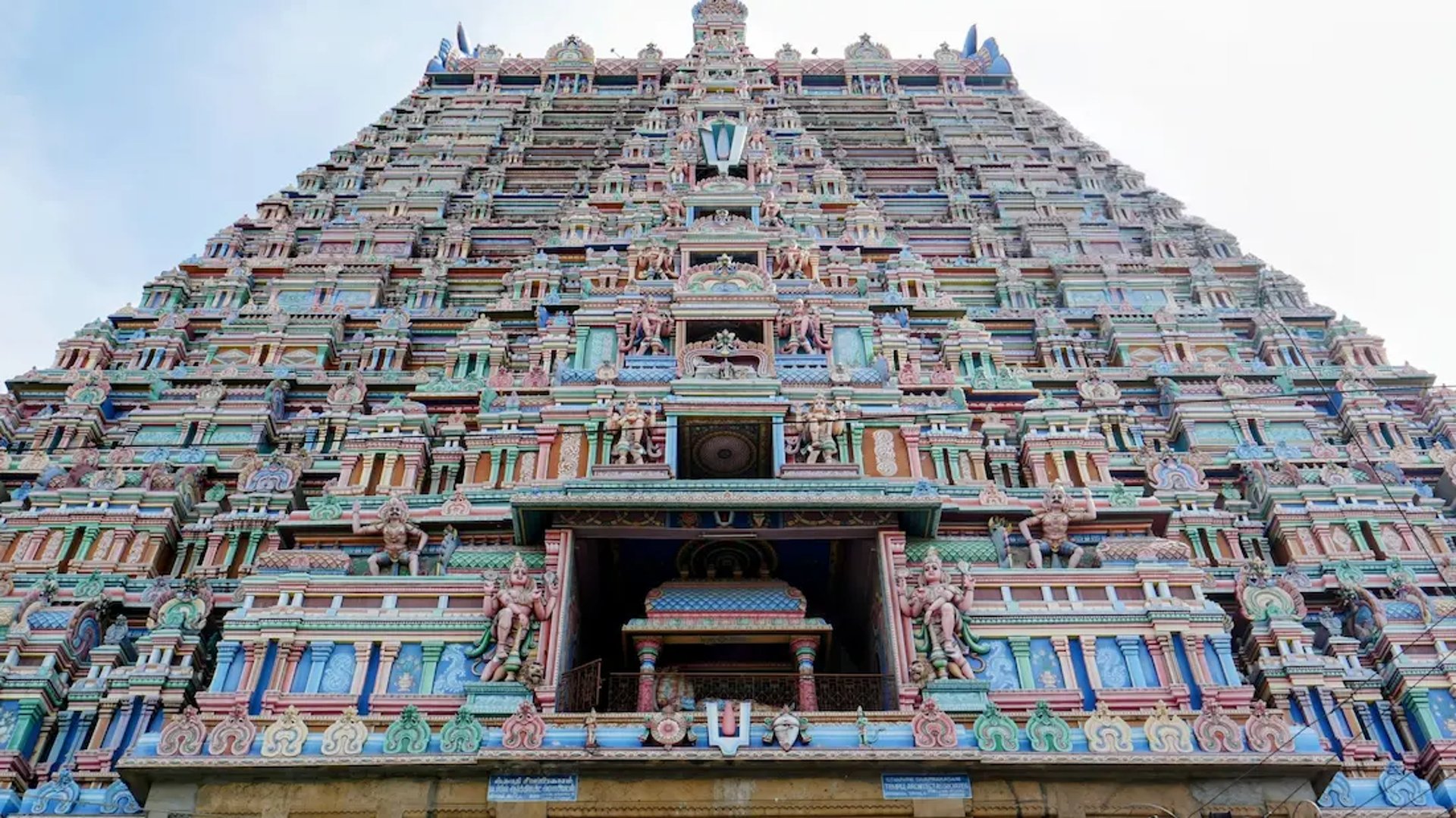
Sri Ranganathaswamy Temple Srirangam – History, Architecture & Travel Guide
Discover the temple’s grandeur, stories, and everything you need to know for your trip.
Sri Ranganathaswamy Temple Srirangam – A Timeless Marvel
There’s something magical about standing before a heritage structure—be it a grand temple, an ancient fort, or a beautiful palace. What fascinates me most is not just their size or design, but the stories they carry—the legends, myths, and history that bring them to life. These tales make travel more meaningful, helping us connect with the culture and spirit of a place.
In India, such stories shine brightest in its temples. From tall gopurams that touch the sky to stone pillars carved with detail, these are more than places of worship—they are living museums of history, art, and devotion.
Among them, one temple truly stands out—the Sri Ranganathaswamy Temple in Srirangam, Tamil Nadu. Known as the world’s largest functioning Hindu temple, Srirangam has always been on my bucket list, not just for its incredible architecture but also for the divine aura it radiates.
Updated on: 12th, Sept 2025
Explored on: June' 2025
Table of Contents
About Srirangam Temple
History & Legends of Srirangam Temple
How to Reach Srirangam – Road, Train, and Air Travel Options
Reaching Sri Ranganathaswamy Temple in Srirangam is convenient, as it is located just across the Cauvery River from Tiruchirapalli (Trichy) in Tamil Nadu. The temple town is well connected by road, rail, and air, making it accessible for pilgrims and travelers from across India.
By Air
The nearest airport is Tiruchirapalli International Airport (TRZ), about 15 km from Srirangam Temple. Regular flights connect Trichy with Chennai, Bangalore, Hyderabad, Delhi, and even international destinations like Singapore and Kuala Lumpur. From the airport, you can hire a taxi or use local transport to reach the temple in about 30–40 minutes.
By Train
Srirangam has its own railway station (Srirangam Railway Station), just 1 km from the temple, with frequent trains from Chennai, Madurai, Coimbatore, and Trichy Junction. For faster connectivity, travelers can also use Trichy Junction Railway Station, one of the busiest in Tamil Nadu, located around 8 km away. From there, autos, cabs, and buses are easily available to reach the temple.
By Road
Srirangam is well connected by road to major Tamil Nadu cities. The Tamil Nadu State Transport Buses as well as private operators run frequent services from Chennai, Madurai, Coimbatore, and Tiruchirapalli. From Trichy city, Srirangam is just a 20-minute drive across the Cauvery bridge. Auto-rickshaws and cabs are readily available, making it easy to reach the temple complex.
💡Travel Tip: If you’re planning a temple tour in Tamil Nadu, Srirangam can easily be combined with nearby spiritual sites like Rockfort Temple in Trichy and Jambukeswarar Temple in Thiruvanaikaval.
Best Time to Visit Srirangam – Season by Season
The Sri Ranganathaswamy Temple in Srirangam can be visited throughout the year, but your experience will vary depending on the season. Here’s a breakdown to help you plan the best time for your trip:
Winter (Nov – Feb) – Pleasant & Festive
This is the best season to visit Srirangam Temple. The weather is pleasant, with temperatures ranging between 18°C and 25°C, making it ideal for exploring the vast temple complex and attending rituals comfortably. The highlight of this season is the Vaikunta Ekadashi Festival, a 21-day grand celebration that attracts lakhs of devotees from across the world. If you want to experience Srirangam at its most vibrant and spiritual form, this is the time to visit.
Summer (Mar – June) – Hot & Humid
Summers in Tamil Nadu can be quite hot, with temperatures soaring up to 40°C. While darshan at the temple is still possible, walking through its seven prakarams during the day can feel exhausting. If you’re planning to visit in summer, aim for early morning or evening darshan to avoid the heat. Carry water and light cotton clothes to stay comfortable.
Monsoon (July – Oct) – Green & Refreshing
The monsoon brings moderate to heavy rainfall to the region. The temple town and its surroundings turn lush and green, making it a scenic time for travelers. However, sudden downpours may affect travel plans. This season is less crowded, so if you prefer a quieter spiritual experience, visiting Srirangam Temple during the monsoon is a good option.
Srirangam offers a variety of accommodations for every type of traveler, from budget-friendly lodges to comfortable mid-range hotels and luxurious stays. Staying near the temple ensures convenience and a serene experience.
Budget Stays
Srirangam Yatri Niwas – Simple, clean rooms close to the temple; perfect for devotees on a budget.
Sri Krishna Residency – Affordable accommodation with basic amenities and merely 0.8 km from Sri Ranganatha Swamy Temple.
Mid-Range Stays
Grand Arcadia – Modern comfort and family-friendly stay, just a short walk from Tiruvanikovil Jambukeswarar Temple.
Hotel Vamanaa Royal – Just 100 meters from Sri Ranganathaswamy Temple, a perfect stay blending comfort with spirituality.
Luxury Stays
Ramyas Hotel Tiruchirappalli – A luxurious option a short drive away, offering high-end comfort and excellent service.
Courtyard by Marriott, Tiruchirappalli – Premium hotel with upscale amenities for travelers seeking a luxurious experience.
Where to Stay in Srirangam


In Tamil Nadu's heart, Srirangam stands,
A temple of faith, built by divine hands
The largest living shrine, holy and grand,
Seven walls encircle this sacred land.
Rajagopuram soars, kissing the sky,
A tower of devotion, where prayers never die.
Stone carvings whisper tales of the past,
Dravidian beauty, built to last.
Rama and Vibhishana’s story lives here,
Lord Ranganatha guards with love so near.
Through invasions and time, it still shines bright,
Glowing golden in the soft night light.
Festivals glow, the crowds all sing,
Chants of faith through the heavens ring.
Timeless and true, its spirit will stay,
A living heritage, lighting the way.
About Srirangam Temple
Deep in the heart of Tamil Nadu stands the Sri Ranganathaswamy Temple in Srirangam, a vast and awe-inspiring structure that feels more like an entire city than a monument. Dedicated to Lord Vishnu in his reclining form, Ranganatha, it is a testament to the grandeur of the region.
Dating back to the 9th century, the temple is considered one of the finest masterpieces of Dravidian architecture. Spread across an astonishing 156 acres, it is even larger than Vatican City and is often described as a “spiritual fortress.” Built on an island formed by the rivers Cauvery and Kollidam, the Srirangam Temple is rightly known as the world’s largest functioning Hindu temple.
What makes it truly unique is its structure. The temple is enclosed within seven concentric walls (prakarams). The inner five surround the main sanctums, while the outer two are living settlements. Nearly 40,000 people still reside within the temple complex, making it one of the few temples in the world where spirituality and daily life exist side by side.
World’s Largest Functioning Hindu Temple
As you step inside the Sri Ranganathaswamy Temple in Srirangam, you are greeted by 21 towering gopurams (temple towers), each more magnificent than the other. The tallest of them all, the Rajagopuram of Srirangam, rises to a staggering 236 feet—almost a hundred feet taller than Delhi’s India Gate. It is the tallest temple tower in Asia and a sight that leaves every visitor spellbound.
In ancient times, the Srirangam Ranganathar Temple was not just a place of worship—it was a complete township. It had its own schools, bustling markets, and even massive granaries, some of the oldest and largest in South India. The temple also houses 12 sacred water tanks (tirthas), two of which can store nearly 2 million liters of water, reflecting how thoughtfully this masterpiece of Dravidian architecture was designed centuries ago. More than just a temple, Srirangam is a living heritage—a sacred city where faith, history, and culture continue to thrive.
Walking through the temple is like stepping back in time. The walls are adorned with hundreds of sculptures, vibrant murals painted with natural dyes, and nearly 800 inscriptions in ancient Tamil, one of the world’s oldest languages. These inscriptions narrate stories of dynasties, donations, and temple life across centuries.
Among its many treasures are 108 depictions of Lord Vishnu in different forms, along with 49 majestic mandapas (pillared halls), each with its own distinct design and purpose. You’ll also notice mythological animal figures like the 'Yali', similar to those seen at the Brihadeeshwara Temple of Thanjavur. Some of these figures are carved from granite, while others include delicate floral motifs. At the very heart of the temple lies the Garbha-Griha (inner sanctum), plated with gold on the outside, radiating divinity and grandeur.
Rajagopuram and Temple Architecture
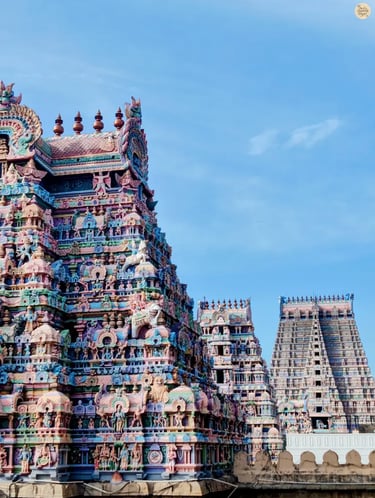

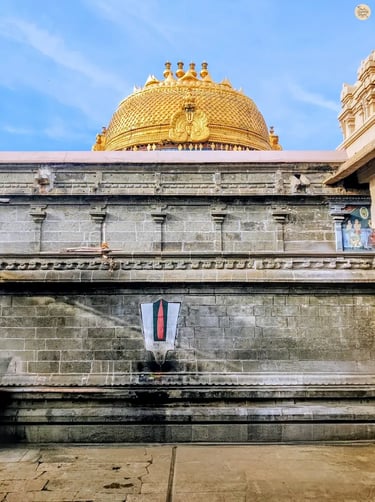

Three gopurams in a row crowned by the majestic Rajagopuram – the pride of Sri Ranganathaswamy Temple, Srirangam.
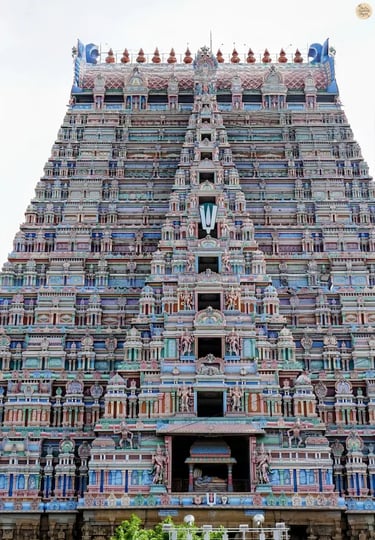

The grand Rajagopuram of Sri Ranganathaswamy Temple – tallest temple tower of Srirangam.
Golden Vimanam of Sri Ranganathaswamy Temple – the shining crown of Srirangam’s spiritual heart.
History and Legends of Srirangam Temple
The story of the Sri Ranganathaswamy Temple in Srirangam begins at the end of the Ramayana. Lord Ranganatha—the reclining form of Vishnu worshipped here—was first venerated by Lord Brahma and later passed down to the Ikshvaku dynasty, the royal lineage of Lord Rama’s ancestors.
After his coronation in Ayodhya, Rama wished to reward each of his loyal companions who had helped him defeat Ravana. Among them was Vibhishana, Ravana’s righteous brother, who had played a crucial role in the victory. When Rama asked him to choose a boon, Vibhishana said, “All I want is you, Rama. Come with me to Lanka and rule my kingdom.”
Rama, bound to Ayodhya yet unwilling to break his promise, offered Vibhishana the idol of Lord Ranganatha that his family had worshipped for generations. Rama told him, “Take Ranganatha with you. If he is with you, it is as good as me being by your side. But remember—do not place him on the ground until you reach Lanka.”
On his way back, Vibhishana stopped at Srirangam to perform his evening prayers. In need of help, he handed the idol to a shepherd boy, who was in fact Lord Ganesha in disguise. Vibhishana cautioned him to call out thrice if he had to leave. As soon as Vibhishana began his prayers, Ganesha softly called his name three times and then placed the idol on the ground. When Vibhishana returned, he was heartbroken to see that the idol had taken root—it could no longer be moved.
In anger, he struck the boy on the head. The place where this occurred later became famous as the Ucchi Pillayar Temple in Tiruchirapalli (Trichy), with “Uchi” meaning “head” in Tamil.
Lord Ranganatha then consoled Vibhishana, saying, “Do not grieve. Though I will remain here in Srirangam, I will always face south and keep my eyes on Lanka, protecting your kingdom.”
This is why the deity at the Srirangam Ranganathar Temple uniquely faces south—unlike most Hindu deities who face east or north.
The Legend of Lord Rama and Vibhishana
Another fascinating chapter in the temple’s story involves its gopurams. Despite having over 20 gopurams, the southern entrance remained incomplete for nearly 400 years. The Vijayanagara king Devaraya began construction, but it was abandoned halfway, and the unfinished tower was mockingly called the Mottai Gopuram—“the bald tower.”
It was only in the late 1970s that the Jeer of Ahobila Mutt resumed the project. After eight years of effort, the Rajagopuram of Srirangam—the tallest temple tower in Asia at 236 feet—was finally completed and consecrated in 1987.
For centuries, devotees believed that completing the southern gopuram would block Lord Ranganatha’s protective gaze toward Lanka. Strikingly, during the 1980s, as the Rajagopuram was completed, Sri Lanka was engulfed in civil war. Many associated this turmoil with the idea that the divine protection of Sri Ranganathaswamy Temple, Srirangam, had been disrupted.
The belief was so strong that Sri Lanka’s former president, Chandrika Kumaratunga, even commissioned a Ranganatha idol from a sculptor in Mahabalipuram for a temple in Colombo. However, the temple was never built, and the conflict continued until 2009.
Beliefs and Divine Protection
Ancient Origins of Srirangam Temple
While the legends are timeless, archaeological evidence suggests that the Sri Ranganathaswamy Temple in Srirangam dates back to around 100 BCE–100 CE, making it one of the oldest continuously active temples in the world. Over the centuries, great dynasties such as the Cholas, Pandyas, Hoysalas, Vijayanagara kings, and Marathas expanded and enriched this marvel of Dravidian architecture with new mandapas, shrines, and intricately carved sculptures.
Every corner of the Srirangam Ranganathar Temple tells a story. The temple walls are adorned with countless stone inscriptions that document donations, royal victories, cultural practices, and temple rituals preserved across centuries. Walking through its vast halls and pillared corridors is like turning the pages of a living history book carved in granite—each inscription, sculpture, and design echoing the devotion and artistry of the ages.
Invasions, Restorations & Survival of Faith
Like many great monuments of India, the Sri Ranganathaswamy Temple in Srirangam has also witnessed periods of turmoil.
In 1311, the armies of Malik Kafur invaded, plundering the temple and desecrating its sacred idols.
Again in 1323, Ulugh Khan (later Muhammad bin Tughlaq) led another assault. This time, tragedy struck during a temple festival—historical accounts recall that nearly 13,000 unarmed devotees were massacred while defending their faith.
Foreseeing danger, the temple priests secretly moved the idol of Lord Ranganatha along with treasures across Tamil Nadu, Kerala, and Karnataka. For nearly 60 years, the deity was worshipped in exile until it was finally restored to Srirangam Ranganathar Temple under the protection of the Vijayanagara Empire in 1371.
With the support of the Vijayanagara rulers, the temple regained its grandeur. New mandapas were constructed, golden roofs were added, and festivals were revived on a grand scale. For over two centuries, Srirangam flourished as the spiritual heart of Vaishnavism, attracting saints, poets, and scholars who enriched its legacy with devotion and learning.
Even after the fall of Vijayanagara, the temple continued to be a focal point of power and worship—its control shifting between the Nayakas, Nawabs, French, and British. Yet, despite wars and politics, the sanctity of the Sri Ranganathaswamy Temple, Srirangam, never faded.
What makes this temple truly remarkable is the fact that it was built over a thousand years ago, without modern machinery, advanced transport, or high-tech equipment. And yet, it still stands tall today—defying the ravages of time, weather, and natural calamities, a living testament to faith and resilience.
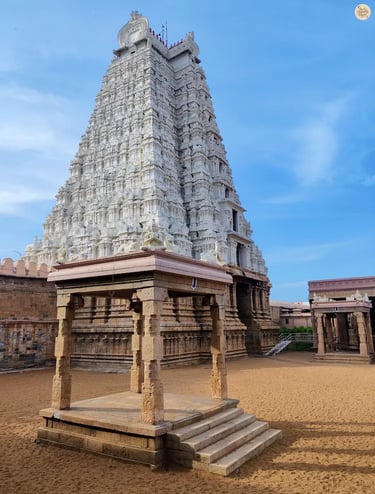

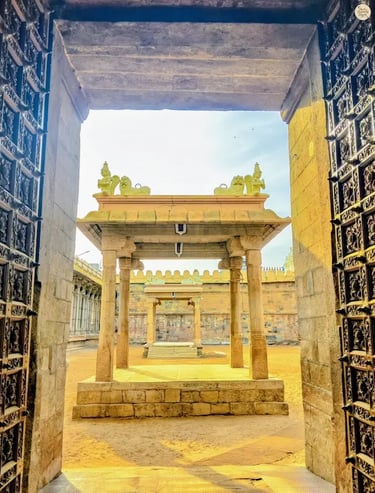

The mysterious White Gopuram of Srirangam – a rare and striking landmark of Sri Ranganathaswamy Temple.
The grand gateway of Sri Ranganathaswamy Temple opening into a sacred courtyard of Srirangam.
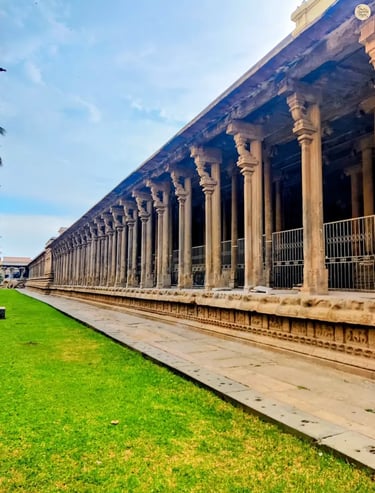

The Thousand Pillar Mandapam – a masterpiece of stone architecture in Sri Ranganathaswamy Temple, Srirangam.
Today, the Sri Ranganathaswamy Temple in Srirangam is not only an architectural wonder but also a living, breathing temple town. Its massive courtyards bustle with pilgrims throughout the day, and the air constantly resonates with sacred Vedic chants. If the temple itself is grand, its festivals are even more spectacular. The annual Vaikunta Ekadashi festival, celebrated for 21 days, attracts over a million devotees from across the world, transforming the Srirangam Ranganathar Temple into a spiritual carnival unlike any other.
For visitors, walking through the temple’s seven enclosures (prakarams) feels like a journey through time—where every stone whispers stories of resilience, devotion, and the undying spirit of Dharma. The experience of being here goes beyond history and architecture; it is about immersing yourself in the living traditions of one of the world’s greatest temples.
Festivals & Spiritual Experience
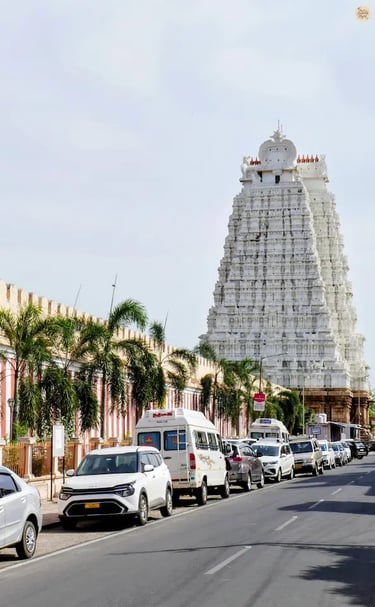

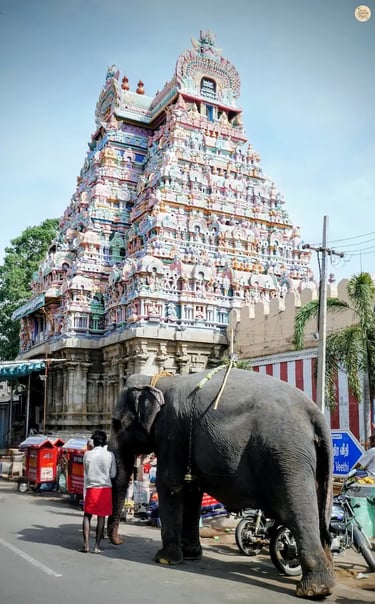

The White Gopuram rising above the fortress-like outer walls of Sri Ranganathaswamy Temple, Srirangam.
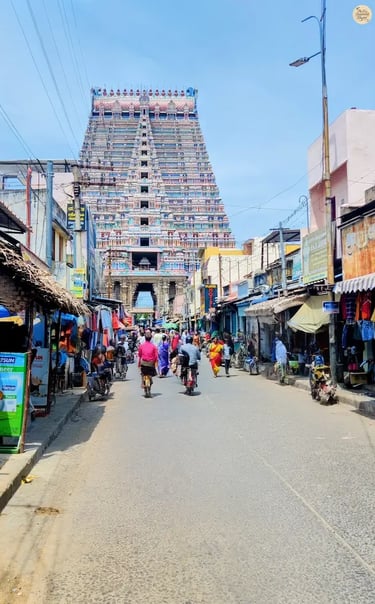

The holy temple elephant of Srirangam – blessing devotees with divine grace.
Bustling market inside the Rajagopuram – where tradition and temple life meet in Srirangam.
Sri Ranganathaswamy Temple Timings & Entry Pass Details
The Sri Ranganathaswamy Temple in Srirangam follows a structured schedule of darshan and daily rituals. Devotees are encouraged to plan their visit as per the timings for a peaceful spiritual experience.
Daily Darshan Timings
Morning Darshan: 6:00 AM – 12:00 PM
Afternoon Break: 12:00 PM – 1:00 PM
Afternoon Darshan: 1:00 PM – 6:00 PM
Evening Break: 6:00 PM – 7:00 PM
Evening Darshan: 7:00 PM – 8:30 PM
Note: Timings may vary during festivals, special occasions, and seasonal changes. Always confirm with the temple authorities before visiting.
Special Pooja Timings at Srirangam Temple
Apart from regular darshan, the temple is known for its sacred rituals and poojas performed at different times of the day.
Viswaroopa Seva (Morning Darshan): 6:00 AM – The first darshan of the day, when the Lord is woken up and devotees can witness the deity in its most divine form.
Archana & Alankaram: 7:30 AM – Special offerings and decoration of the deity.
Uchikala Pooja (Midday Pooja): 12:00 PM – Midday offering with naivedyam and rituals.
Sayarakshai (Evening Pooja): 6:00 PM – Evening prayer when the Lord is offered food and rituals are performed before rest.
Aravanai Pooja: 7:30 PM – The deity is prepared for the night's rest with final offerings.
Ekanta Seva (Final Ritual): 8:30 PM – The Lord is laid to rest with lullabies and devotional chants, marking the temple’s closing.
Entry Pass for Special Poojas and Quick Darshan
If you wish to take part in certain special poojas, sevas, or quick darshan services, you’ll need to get a paid entry pass.
Online Booking: Visit the official temple website and follow the steps to reserve your pass.
Offline Booking: Collect your entry pass directly from the ticket counter located at the temple entrance.
💡Travel Tip: If you wish to attend Viswaroopa Seva (the earliest and most sacred darshan), reach the temple by 5:30 AM as it draws many devotees.
The story of Srirangam is not just about invasions and restorations. It is about unshakable faith that withstood centuries of adversity, about the courage of devotees who risked everything to protect their deity, and about the resilience of a spiritual tradition that continues to thrive even today.
The Sri Ranganathaswamy Temple in Srirangam is not merely a place of worship—it is a living heritage site, a thriving cultural hub, and an architectural marvel of Dravidian temple design. Every stone here echoes with the voices of dynasties, artisans, saints, and devotees who shaped its legacy over the past thousand years.
To visit the Srirangam Ranganathar Temple is to witness history, spirituality, and art blending together in one breathtaking journey. Truly, temples like this are rare—and the story of the Sri Ranganathaswamy Temple Srirangam is one that continues to unfold even today.
Standing tall as the world’s largest functioning Hindu temple complex, Srirangam is not just a destination but a reminder of the enduring power of faith, unity, and devotion. And as always on The Roaming Rhyme – Tracing the Path Unknown, it is journeys like these that remind us why travel is more than movement; it is connection with timeless stories that live on through places, people, and faith.
Frequently Asked Questions – Srirangam Temple Travel Guide
Q. Where is Sri Ranganathaswamy Temple located?
A. The temple is located in Srirangam, an island town in Tiruchirappalli (Trichy), Tamil Nadu, between the Kaveri and Kollidam rivers.
Q. Why is the Srirangam Temple famous?
A. It is the world’s largest functioning Hindu temple and a major Vaishnavite pilgrimage site dedicated to Lord Vishnu in his reclining form as Ranganatha.
Q. What are the temple timings in Srirangam?
A. Darshan is generally available from 6:00 AM to 12:00 PM, and again from 1:00 PM to 8:30 PM, with short breaks in between.
Q. What is the best time to visit the temple?
A. November to February is the most pleasant season. For spiritual vibrance, plan your visit during Vaikunta Ekadasi.
Q. How can I reach the Srirangam Temple?
A. The temple is just 12 km from Tiruchirappalli city. The nearest airport is Trichy International Airport, and the Srirangam railway station is well-connected to major cities.
Q. How many gopurams (temple towers) does Srirangam Temple have?
A. The temple has 21 gopurams, including the towering Rajagopuram, which is 72 meters high and the tallest in Asia.
Q. What is special about the Rajagopuram?
A. The Rajagopuram, completed in 1987, stands 236 feet tall and is a major landmark visible from miles away.
Q. How old is the Sri Ranganathaswamy Temple?
A. The temple has ancient origins, with inscriptions dating back to the 6th century, and it has been expanded by Chola, Pandya, Hoysala, and Vijayanagara kings.
Q. Is the cloak room available in the Srirangam temple?
A. Yes, the Sri Ranganathaswamy Temple in Srirangam has a cloakroom located near the Ranga Ranga gopuram, which is available for visitors to store personal belongings and footwear for a nominal fee.
Q. What are the main attractions inside the temple?
A. Main attractions inside Srirangam's Sri Ranganathaswamy Temple include the Golden Vimana covering the sanctum, the large Thousand-Pillared Hall, the sacred Swarga Vasal (Heaven's Gate), various shrines such as the Venugopal Shrine, and the Sesha Mandapa.
Q. Is photography allowed in Srirangam Temple?
A. Mobile phones and cameras are generally not allowed inside the sanctum of the temple to maintain its sanctity. However, they can be used in designated areas outside the main halls. There is also a terrace viewpoint where you can see all 21 gopurams together. For mobile photography from this spot, a fee of ₹50 is charged.
Q. Is there a dress code for entering the temple?
A. Yes, visitors are expected to wear traditional Indian attire, such as a saree, half-saree, or salwar kameez for women, and dhotis, pyjamas with an upper cloth, or shirts and pants for men.
Q. What are the nearby places to visit around Srirangam Temple?
A. Nearby attractions include the Rock Fort Temple in Tiruchirapalli (Trichy), the Jambukeswarar Temple at Thiruvaanaikaval, and the historic Kallanai Dam (Grand Anicut). Each of these sites adds to the spiritual and cultural charm of the region, making them perfect stops along with your visit to the Sri Ranganathaswamy Temple in Srirangam.
Share Your Thoughts – We’d Love to Hear From You!
Every journey is better when shared.
We hope you enjoyed this travel story — now, we'd love to hear yours! Share your experience, suggestions, or feedback and help us make our travel tales even better.
